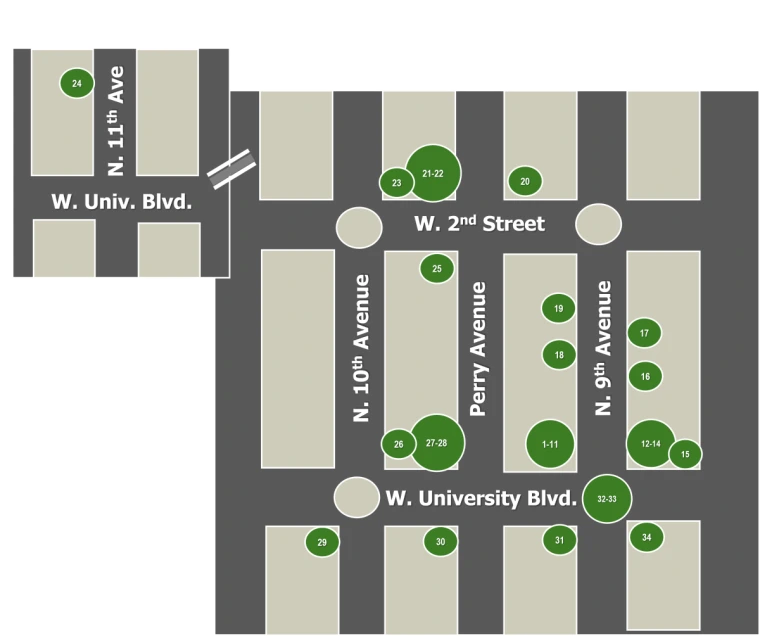Dunbar Spring Neighborhood Foresters
Recommended Plant List for the Tucson Basin and Foothills.
This project builds on previous work with the Dunbar Spring Neighborhood Foresters in which 20 native plants were identified, described and interpreted by University of Arizona Campus Arboreutm student who produced signage with QR codes linking to web content relating to the cultivation and use of plants growing in the Dunbar Spring neighborhood. You can see more on that project here. The initial 20 plants featured in the earlier work are listed below along with an additional 14 native woody plants including sub-shrubs, shrubs, and trees. By following the map below, you may visit the neighborhood located west of the University of Arizona and participate in a self-guided walking tour of trees and plants marked with arboretum signage.

You can also click on the links below for each species in the tour for a virtual educational experience.
The compilation of recommended woody plants included in the Dunbar Spring Neighborhood Foresters Tours includes:
- Acacia constrica | whitethorn acacia | huizache | Giidag
- Agave murpheyi | Murphey's agave, Hohokam agave | maguey | A'ud
- Aloysia wrightii | desert oregano | oreganillo
- Ambrosia deltoidea | triangle leaf bursage | Chicurilla | Ñuñui Je:j
- Ambrosia ambrosioides | canyon ragweed | Chicura | Taḍṣagĭ
- Calliandra eriophylla | pink fairy duster | huajillo | Cu:wĭĭwuipo
- Carnegiea gigantea | saguaro | ha:san | sauwo
- Celtis pallida | desert hackberry | garambullo | Kuwavul
- Celtis reticulata | canyon hackberry | garabato | Koom
- Chilopsis linearis | desert willow | mimbre | A:n
- Cholla versicolor | staghorn cholla |cholla | Ciolim
- Condalia warnockii | frutillo | U:spaḍ (U:spadt)
- Encelia farinosa | brittle bush | rama blanca | Tohaws, Tohawes
- Ephedra trifurca | Mormon tea | canutillo | kubgam
- Ferocactus wislizeni | fishhook barrel cactus | biznaga de agua | chiávul
- Fouquieria splendens | ocotillo | ocotillo | Melhog
- Gossypium thurberi | desert cotton | algodoncillo | Ban Tokiga
- Hyptis emoryi | desert lavender | salvia | Wiopal
- Jatropha cardiophylla | limberbush | sangrengado | Wa:s
- Justicia californica | chuparosa | chuparosa | Vipismal Jeej
- Larrea tridentata | creosote bush | hediondilla | Ṣegai
- Lycium fremontii | wolfberry | tomatillo, fruitilla | Kuáwul
- Mammillaria grahamii | pincushion cactus | cabeza de viejo | Ba:ban Ha-:swigĭ
- Olneya tesota | ironwood | Tésota / palo fierro | Ho’idkam
- Opuntia engelmannii | Engelmann's prickly pear | nopal | L:ibhai naw
- Opuntia leptocaulis | Christmas cholla | tasajillo | Aj Wipinoi
- Parkinsonia microphylla | foothills palo verde | Palo Verde | Kuk Chehedagi
- Prosopis pubescens | screwbean mesquite | Tornillo | Kuujul
- Prosopis velutina | velvet mesquite | mezquite | Kui
- Parkinsonia florida | blue palo verde | palo verde | Ko' Okma
- Senegalia greggii | catclaw acacia | uña de gato |U:paḍ
- Simmondsia chinensis | goat nut, jojoba | jojoba | Hohowai
- Yucca elata | soaptree yucca | palmilla, yuca, sota, datil | takwi
- Ziziphus obtusifolia | graythorn | barchata | U:spad
Criteria for Inclusion:
Plants are listed by their SCIENTIFIC NAME then COMMON NAME(S) in English, Spanish, O’odham, and Yeome (to try to begin connecting with the area's rich cultural heritage). Only plants native to Arizona are featured in this list. The vast majority (95%) are also native to Pima County. Since this list is specifically geared for use within the Tucson basin and foothills, all listed plants are found in an elevation range at or within 1,000' of Tucson's elevation of 2,500'. Those found at the higher elevations will need added protection (afternoon shade, cooler microclimates) to do well in our intense summer heat, while those found at lower elevations may be less tolerant of winter cold, and need to be planted in warmer microclimates (ex. to the south side and under the protective canopy of other plants).
Water Needs:
Where water needs are noted:
- LW = low water or 10 - 20 inches of water per year
- MW = medium water 20 - 35 inches per year
- HW = high water 35 - 50 inches per year.
Irrigation:
Where irrigation needs are noted as 1,2,3,or 4 - signifying approximate irrigation needs of the plants after the first two years of establishment (after transplanting).
- "1" = no supplemental irrigation
- "2" = once a month irrigation during the growing season
- "3" = twice a month irrigation during the growing season
- "4" = once a week during the growing season.
Water Harvesting:
Where preferred rain garden planting zone is noted:
- Bottom – typically the bottom of a basin or swale, which is prone to temporary pooling of water and cold air
- Terrace – typically atop a terrace or pedestal on a bank of, or within, a basin or swale, where temporary pooling is shallower and less frequent than the bottom zone
- Top – area beside a basin–and neither in nor on the banks of the basin–where the plant’s roots can access water harvested in the basin; including the top of a berm. This is the driest and warmest of the three zones.

